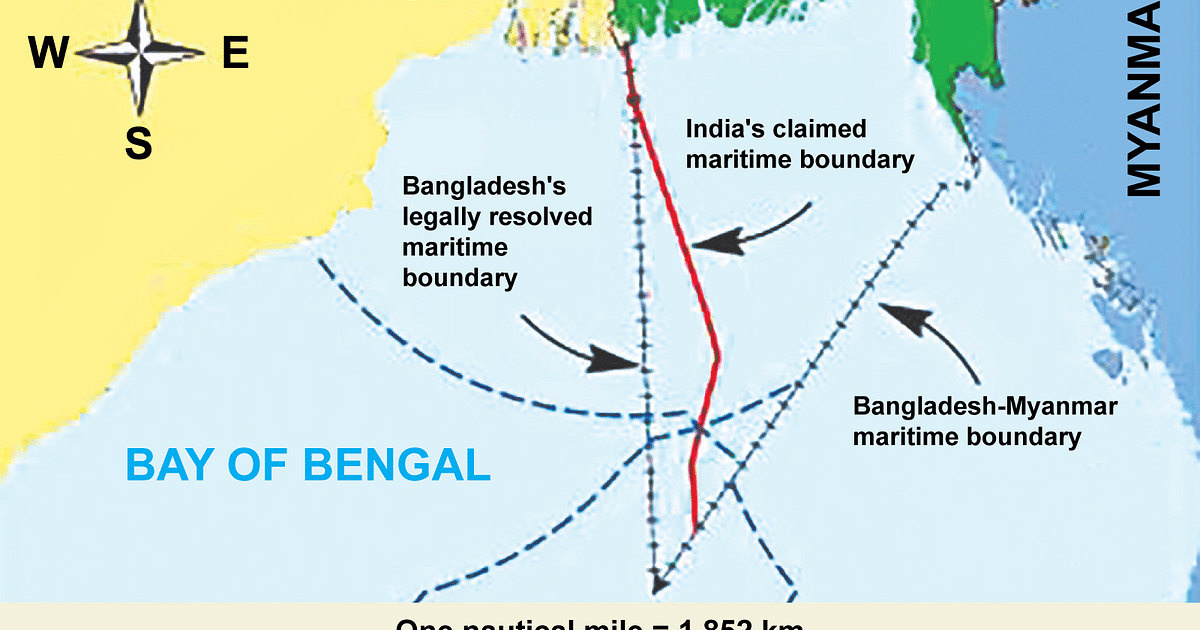A part of the coastal baseline used by India to determine its maritime boundary has jutted into Bangladesh's maritime boundary. Bangladesh has tried to resolve the issue bilaterally over the past seven years, but to no avail. Finally on 13 September, Bangladesh sent a letter to the United Nations secretary general, apprising him of India's position on the issue.
Sources in Bangladesh foreign ministry have said that the letter has been sent from the Bangladesh permanent mission in the UN headquarters in New York to the UN secretary general. The letter has been published on the UN website.
In the meantime, India issued a letter to the United Nations in April, raising objections to Bangladesh's argument in favour of its claim regarding the continental shelf in the Bay of Bengal.
Bangladesh sent another letter to the UN secretary general on 13 September in response to that letter of India. In its letter, Bangladesh contended that Dhaka determined its claim to the continental shelf on the basis of the verdict passed in 2014 by the international arbitral tribunal.
A continental shelf is the part of the land of coastal countries that slopes down and is gradually submerged in the sea. The continental shelf extends straight from the baseline of the coastal countries for 350 miles. Of this, the concerned country has sovereign rights to 200 miles of this area. No other country can fish or claim mineral resources in this area. After this 200 miles, the country has sole rights to the mineral resources for the next 150 miles, but other countries can fish in these waters.
Seven years of futile efforts
India has been using a coastal baseline since May 2009 to determine its own maritime boundary. In October 2009, Bangladesh wrote to the Indian foreign ministry, protesting against this baseline. It said that a part of this baseline was in Bangladesh's territory and requested for the error to be amended. In 2014 the international arbitral tribunal gave its verdict, determining the maritime boundary of the two close neighbours, after which Bangladesh requested for the baseline matter to be resolved bilaterally. India, however, did not respond.Speaking to Prothom Alo about the matter on Friday evening, former foreign secretary Touhid Hossain said both sides had accepted the verdict passed by the international arbitral tribunal in 2014 regarding Bangladesh and India's maritime boundary dispute. There can be no new measures after that verdict, he said.
In a letter sent to the UN secretary general on 13 September, Bangladesh said that the matter became murky when India raised objections with the UN Commission on the Limits of the Continental Shelf in April about Bangladesh's continental shelf issue. India claimed that the baseline used by Bangladesh to determine the continental shelf was part of India's continental shelf. India requested the UN Commission on the Limits of the Continental Shelf not to take Bangladesh's claim into consideration. After that Bangladesh decided to inform the UN about the efforts made to resolve the matter bilaterally.
In its letter to the UN secretary general, Bangladesh said for long it had refrained from informing the UN and member states about the matter. Now, however, Bangladesh was clearly opposing this stand of India. Bangladesh will continue to oppose this for as long as India does not resolve the matter and inform the UN accordingly.
In its objection to India's baseline issue, Bangladesh explained that in 1976 India enacted its Territorial Waters, Continental Shelf, Exclusive Economic Zone and other Maritime Zones Act. After 33 years, in 2009, it brought about an amendment to determine the baseline. Earlier the rule was to determine the baseline from the lower level of the sea, but presently they are using the 'straight line baseline', which is contrary to Section 7 of the United Nations Convention of the Law of the Sea (UNCLOS).
While the rule is to determine the baseline from the coast, some of India's baselines are determined from the sea. The base point 87 is from the sea, around 10 nautical miles from the India coast. India's base point 89 is around 2.3 miles within Bangladesh's maritime boundary. Bangladesh is particularly concerned about this, highlighting the matter in its letter to the UN.
Secretary of the Maritime Affairs Unit of Bangladesh's foreign ministry, Admiral (retd) Md Khurshed Alam, told Prothom Alo, "The manner in which India has determined its baseline is contrary to Section 7 of UNCLOS. That is why we have put forward our objection." The Indian high commission was contacted on Friday evening for comment on the matter, but no comment has been available so far.
Letter claiming continental shelf
Earlier in April this year, India issued a letter to the UN, objecting to Bangladesh's claims concerning the continental shelf. In the letter, India requested the UN not to take Bangladesh's claims into consideration.Following this letter sent in April by India, Bangladesh wrote a letter to the UN secretary general on 13 September, saying that that the continental shelf had been determined in accordance to the verdict of the international arbitral tribunal in 2014. The two countries determined their maritime boundaries after this verdict was passed. The boundary point was officially declared by means of a notification. There can be no conflict after that, Bangladesh stated in its letter.
Admiral (retd) Khurshed Alam said, the UN arbitral tribunal resolved the conflict between the two sides concerning the boundary. After that, there can be no justification for any other claim to be acceptable to the United Nations.

Objections to India's coastal baseline
India's coastal baseline point 89 is around 2.3 miles within Bangladesh's maritime boundary. This is a cause for concern for Bangladesh





